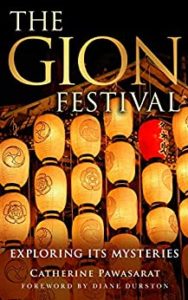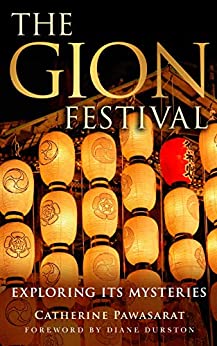Review by Cody Poulton
It’s a bitter irony that a festival that is nearly as old as Kyoto, dedicated to ridding the city of pestilence in the hot and sticky month of July, was cancelled by the world-wide coronavirus pandemic last year. 2021 bodes no better: the great processions of splendid floats through the city, usually held on July 17 and 24, have been cancelled again. But until the time we can all go again to the Gion Festival, we can prepare, thanks to the new guide The Gion Festival: Exploring its Mysteries.
Author Pawasarat compares the Gion Festival to a vast Tibetan sand mandala that is destroyed shortly after its construction. Thus, it not only symbolizes Buddhism’s intricate map of the spiritual universe, but also demonstrates one of its central truths, that nothing lasts. Like all performances, however much work goes into it, it is to all intents and purposes gone once the event is over. The Gion festival originated in a rite of purification, called a goryō-e, commissioned by Emperor Seiwa to placate evil spirits thought responsible for a plague that ravaged the city in 869 CE. Seiwa ordered a procession of sixty-six hoko (pikes) to be carried through the city in an effort to transform the evil spirits (onryō) into benevolent spirits (goryō), evidence of, Pawasarat writes, the shamanistic roots of many Shinto practices. It became an annual rite in 970 CE and has been held pretty much continuously ever since.
A key element of this festival is the vast amount of priceless works of art—textiles, wooden sculptures and structures, paintings and metalwork—that have been the pride of Kyoto’s townspeople since at least the middle ages. The Gion Festival is a nexus of several rites, exhibitions, and performances that converge in Kyoto in July to celebrate the gods of Yasaka Shrine and numerous other spirits and culture heroes represented by 34 floats erected by individual neighbourhoods in central Kyoto. Festivities ceased during the Ōnin War (1467-77), which destroyed most of the city, and by the late 15th century, the centre of cultural production had passed from the Kyoto court and samurai aristocracy to the wealthy merchant class who lived in the centre of town. The Gion Festival became a stage to display their treasures and impeccable artistic taste, and became the model for many other pageants across Japan. Scholars have called this fūryū (“elegance”), a performance type that flourished from the 16th century to show off the pride of the wealthy urban commoner.
As much a symbol of the unique culture of Kyoto (Japan’s capital for over a millennium), what’s on display is astoundingly cosmopolitan, presenting artworks from as far afield as China, India, Persia, and even present-day Belgium. The art depicts scenes and motifs not only from Shinto and Buddhism, but Taoism, Confucianism, Judaism, Christianity, Islam, and Greco-Roman mythology, demonstrating that Kyoto was in touch with the world from as early as the middle ages. Local masters like the 16th-century Hasegawa Tōhaku and 17th-century Maruyama Ōkyo also contributed works to the festival.
An important sidelight to the procession of floats is an event called the byōbu matsuri, in which many of the wealthier old establishments in the centre of town open their homes to the public to display their priceless kimono, folding screens and other treasures from their storerooms. New works by some of Kyoto’s finest artists are still being commissioned, attesting to the fact that the festival is not a museum.
Yet Kyoto and the Gion Festival have always been under threat. Many of the splendid floats and other priceless artwork were destroyed in the Great Genji Fire of 1864, sparked by the civil war between pro and anti-Shogun forces at the end of the Edo period. The U.S. Occupation of Japan from 1945-1951 banned public gatherings and curtailed many of the Gion festival events in the immediate postwar period too. Despite centuries of fire and civil disturbance, the people of Kyoto have managed to rebuild their floats, revive ritual performances, and keep this 1,150-year-old tradition very much alive.
Still, it hasn’t been easy. The bursting of the economic bubble in the 1990s led to the demise of many of the textile firms that had been the mainstay of the Kyoto economy and patrons for the festival. During the same time, many of the old machiya, the traditional townhouses that are a symbol of the distinctive Kyoto townscape, were torn down to build nondescript office buildings and condominiums. And now, a pandemic is testing the tenacity of tradition.
Any first-time visitor to Kyoto will be struck by the beauty of its traditional architecture and gardens, but those who stick around know only too well the cavalier attitude with which many residents seem to regard their material culture. The respect for private property over historical preservation, combined with the impact of inheritance taxes on struggling family businesses, has meant the loss of many of the venerable machiya that have supported the Gion Festival for centuries. In a country prone to fires and earthquakes, it has generally been intangible culture—practices passed down by oral tradition—that have embodied whatever might be called the essence of Japan. Many lifelines to the preservation of this festival have thereby been severed.
As Pawasarat writes, “as the social fabric of its inter-generational communities thins in downtown Kyoto, traditions are conveyed less by direct hands-on experience and word of mouth” (p.204). Crowd-funding, soliciting new residents, digitally recording and archiving of precious artworks, and documenting work of university students and researchers to digitally record and archive art and documents pertaining to the festival are the current means to preserve what had been essentially an oral tradition.
Another change has been the attempt to make the festival more accessible to women. Some floats, like the Naginataboko (perhaps the most important since all processions begin with it) are off-limits to women. Scholars like Wakita Akiko, however, have made clear that women played an instrumental role in creating many of Japan’s traditional performing arts, such as noh and kabuki. I suspect that women were prevented from participating in many of the Gion Festival activities because of the Tokugawa Shogunate’s ban on women from public performances in 1629, though the tendency to exclude women from many events had been ongoing for some centuries before. Some traditions can and should be changed, but Pawasarat recognizes that community standards cannot be changed overnight.
Even at the best of times crowded, the Gion Festival is as much an ascetic rite as an attraction. Pawasarat calls it Kyoto’s version of a sweat lodge. For much of the postwar period, ritual events had become stripped down, resulting in a single procession of floats on July 17. This was the Gion Festival familiar to me, but in 2014, the previous system of two traditional processions was restored: the Saki Matsuri (early festival) on July 17 and the Ato Matsuri (later festival) on July 24, to celebrate first the descent of the gods from Yasaka Shrine into the city centre and, later, their return. The Saki Matsuri remains the largest pageant, with some 23 floats, combining hoko with the tall pikes atop their roofs, and yama (mountains) adorned with pines, dominating the Ato Matsuri. Both pike and pine are yorishiro, essentially lightning rods, down which the gods descend from the heavens to inhabit the floats during the time of the festival.
Pawasarat writes that, in addition to the restoration of the two processions of yamaboko, several floats previously lost to fire or neglect, such as the Ōfuneboko have been reintroduced after scrupulous research and fundraising. The Gion Festival was given UNESCO world heritage status in 2009, which no doubt helped support its preservation as well as made it a destination for even more visitors to Kyoto during one of the hottest months of the year. As Pawasarat writes in her foreword, “with more than a millennium of rich history, the Gion Festival offers an excellent case study for sustainability and community resilience” (p. 7). “What positive roles can tourism play in this?” she asks. Like many historic attractions around the world, Kyoto has suffered from over-tourism. Pawasarat notes that, with only eleven floats, the less opulent and crowded Ato Matsuri preserves some of the cozy community character of festivals of yesteryear.
The sheer scale of the Gion Festival and the variety of activities contributing to it sometimes make it seem more like a labyrinth than a mandala to a visitor. The pedant in me looks for a bibliography and I was a bit disappointed there was none, nor an index. Hundreds, even thousands, of studies have been written in Japanese about this festival, perhaps more than anything else in this city. Yet Pawasarat has certainly done her homework. She lived for some twenty years in Kyoto, much of that time in a machiya in a neighbourhood that sponsors one of these floats, where the author was effectively adopted by her chōnai. Her familiarity and fascination with this ancient festival enabled her to make friends with many in Kyoto who make this event an annual occurrence; dozens of them are credited in her acknowledgements for the expertise they have shared. Generous footnotes guide the reader to other sources and many of the floats and the traditional houses that support them have their own websites in English and other languages as well as Japanese.
I received a complimentary copy of the book for review, but there is so much here that I bought the Kindle version too, which has the advantage of hyperlinks to relevant information, and serves as its own index. The author has provided a well-maintained and informative website as well as a Youtube channel of videos she has taken over the years. No matter what form of the book you buy, it’s full of sumptuous colour illustrations that give the reader a vivid impression of the festival’s beauty and religious significance. Maps chart the course of processions and tell you where to go to see the attractions.
This is the first English guide to this extraordinary festival in close to a century. You’ll need it to make sense of the colourful chaos around should you decide to brave the heat.


